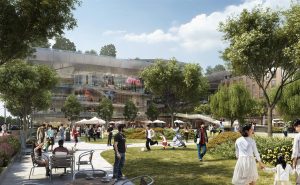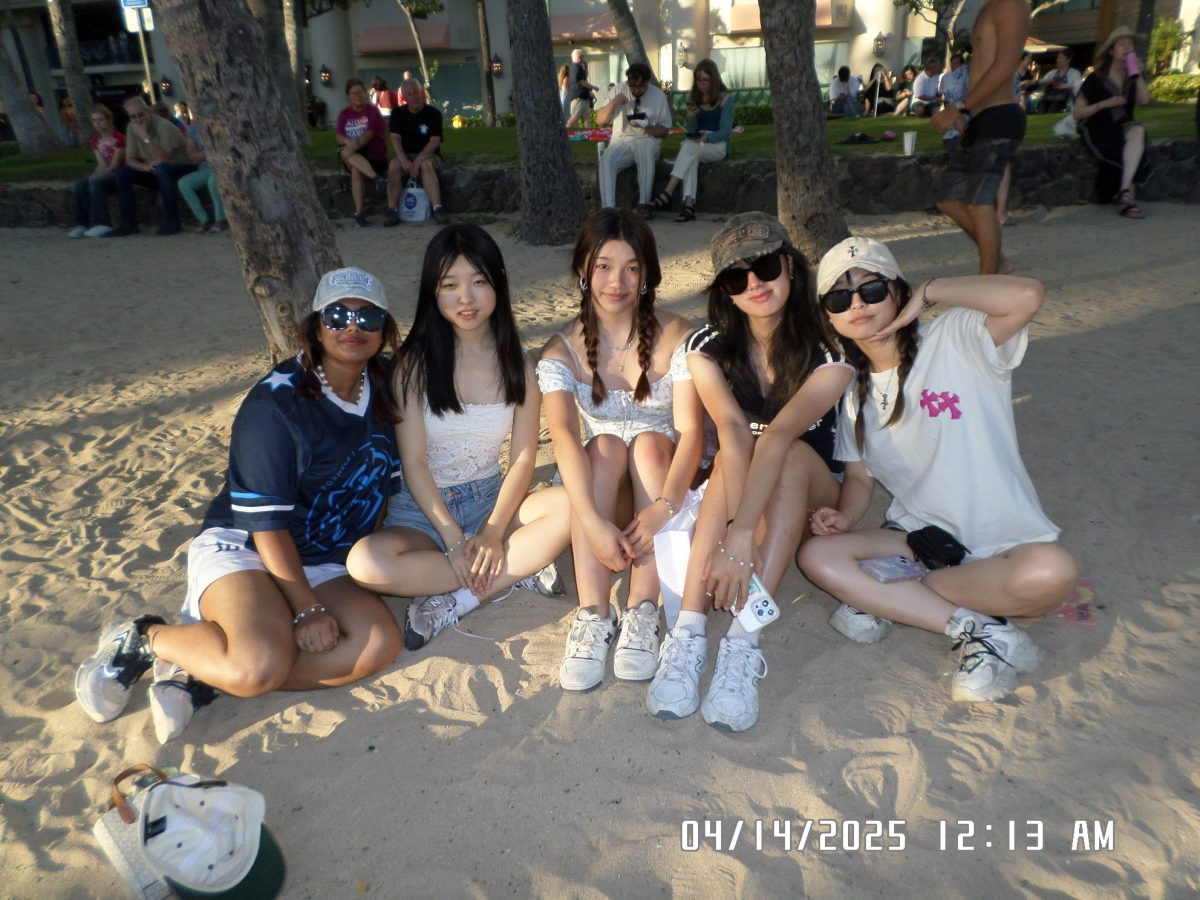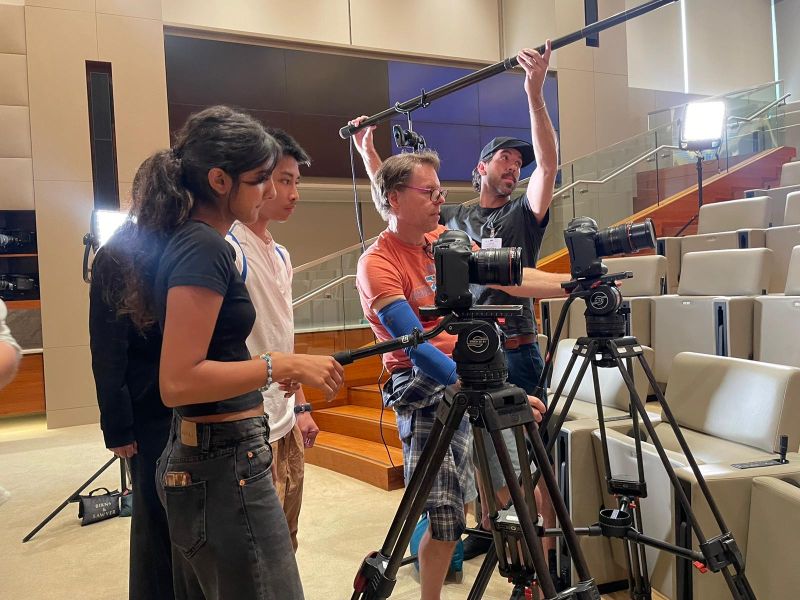Co-written by Dylan Tsai.
D rive down Stevens Creek, and the signs of change are all there. A fence hides the acreage of Apple’s construction projects. Two-story red and white apartments stand across Vallco where an empty lot sat just years ago. And then Vallco Shopping Mall itself, an increasingly vacant mall that a Silicon Valley real estate company is trying to bring back.
In 1976, Vallco was the place to be. Vallco parks became an instant hit in the region upon opening, drawing customers from many different areas. However, that is not the Vallco of today, which bares empty, echoing hallways and vacant storefronts.

Sand Hill Property Company, founded by Peter Pau and Susanna Pau in 1988, is a Silicon Valley real estate development company responsible for creating the De Anza Plaza, Hilton Hotel and Arioso Apartments in Cupertino. Now, it’s set on bringing life back to Vallco.
Sand Hill Property Company’s managing director Reed Moulds explained Vallco’s loss of consumer traffic when it was bought out by three other companies. Any change required consent from all three property holders, which rarely happened. Meanwhile, nearby shopping centers and Westfield Valley Fair began attracting more customers. By 2005, the lower part of Vallco was shut down.
According to Sand Hill, Vallco will soon be Cupertino’s main hub. After unifying Vallco Shopping District under its ownership, Sand Hills Co. has held meetings with Sand Hill developers, FUHSD PTSA members, and regular Cupertino residents, and there finally seems to be a direction and goal for the Vallco project.
“Vallco is part of [Cupertino’s] history,” said Helene David, president of the Cupertino Historical Society, which works to preserve Cupertino’s heritage. “Even as it changes, it’ll still be part of that history.”
According to Moulds, the Cupertino city council will most likely vote on the plan in one year. If accepted, he explains that it will only take about five to six years to construct because the company already has their plans and the necessary funds — the entirety of the $3 billion — needed to build the shopping center ready.
“We started this project in a way that we don’t always start projects,” Moulds said. “We came to the community and we asked [the public] what [they] thought. And that’s not going to change.”
Better Cupertino
Liang Chao, founder of a group of residents known as Better Cupertino who discuss changes in Cupertino, voices her doubts about Vallco’s suggested development project.
Chao explains how many people who work in Cupertino do not live within the bounds of the city. When Vallco constructs the 2 million sq. ft. of office space, Chao believes that there will be no place for the new workers to live, forcing them to reside outside of Cupertino, increasing both traffic and greenhouse gases as a result of more people on the road. Though the plan proposes shuttles, Chao suspects that because the shuttles would be within Cupertino, workers would still be unable to use them to get to work. As Vallco’s new plan calls for only 625,000 sq. ft. of retail, Chao asserts that residents will also be forced to drive out of the city to shop.

“If we want to revitalize Vallco, that doesn’t mean revitalize so it generates profit for the developers; it doesn’t mean revitalize so it generates more revenue for the city,” Chao said. “That’s a secondary goal. The main goal is that it’s revitalized for the community surrounding Vallco, for Cupertino residents so that we have a lively mall where we can go and shop.”
Chao also believes that the proposed effects on the school have been dramatized. She says that because schools in Cupertino have an overcrowding problem, the creation of an innovation center—a congregational area of Vallco for high school students— would not alleviate this problem in any of the high schools of FUHSD. The addition of 800 housing units is worrisome to Chao, who sees the housing units as an increase in students entering the district.
Chao believes that the way to fix Vallco is to hire national renowned retail consultants who are experts at restructuring malls to attract more people by analyzing spending patterns to find out what types of shops Cupertino needs.
“Are [they] revitalizing Vallco as a mall,” Chao asked, “or are [they] just turning it into an office center to so [they] can make more money?”
VOICES ON VALLCO
Three students explain their perspectives on the proposed Vallco reconstruction
Senior Nirupama Chandrasekhar shopped at Vallco avidly and will only faintly miss the shops that she once shopped in. The under-crowded and cheap mall was enjoyable, but the idea of sustainable technology and the forward-thinking planning that went into these designs are far more interesting.

She sees this as a way to revitalize Cupertino’s downtown, which would not directly affect the MVHS student body, but would nevertheless be a good investment to the future.
“A lot of people here complain about Cupertino being boring and there not being enough to do here, so they go elsewhere,” Chandrasekhar said.
Though she sees the possible increase in traffic and noise disadvantages in the Vallco plans, Chandrasekhar classifies them as small in comparison to the revenue that the city would gain and the ability for children to have a place to congregate.
Additionally, the idea of having a green roof appeals to Chandrasekhar because she believes that having the nature amidst the town would not only be good for the environment, but would also be aesthetically pleasing.
Junior David Chen went to Vallco as a child for ice skating lessons with his friends. Now, he goes to Vallco with his friends for movies or with his parents for dinner. Other than that, to Chen Vallco is useless. The idea of a green roof appeals to Chen. He could relax with his friends and watch a movie at AMC in one outing.

“I’ve always wanted a green place where I could relax and hang around with friends,” Chen said. “I feel like green is a nice color to see in urban environments.”
But even if it proves to be a success, he won’t be able to enjoy it because the construction would not finish until he leaves for college. The change of Vallco would result in Chen losing his memories of Cupertino life, but because of the general positive impact it could have on the community, he has an overall neutral stance.
Senior Aarohi Palkar is saddened by the prospect of Vallco closing. To buy the cheap clothes she wants, she would have to travel farther outside of Cupertino or endure online shopping where she can never find the right clothes size. And if she had to return something, there’s nowhere in the vicinity to return items.
“It’s like living in the middle of nowhere,” said Palkar.

One of the largest problems Palkar sees is how unaware students are of these changes. Though she believes that the project isn’t largely advertised, when people do hear about it, they seem to be really passive. Palkar hadn’t noticed that Vallco was changing until Macy’s closed its doors.
“We’re not completely devoid of things to go to,” Palkar said. “It’s just a lot more effort driving to places outside if you really want lower prices.”
Palkar believes that the plan overall benefits the company more than the residents of Cupertino.







